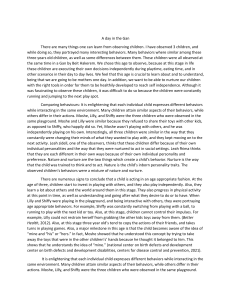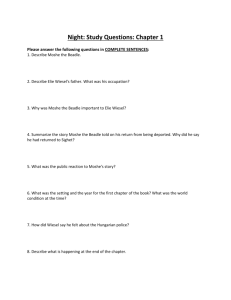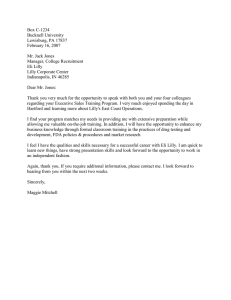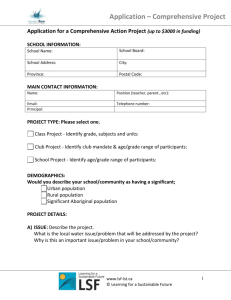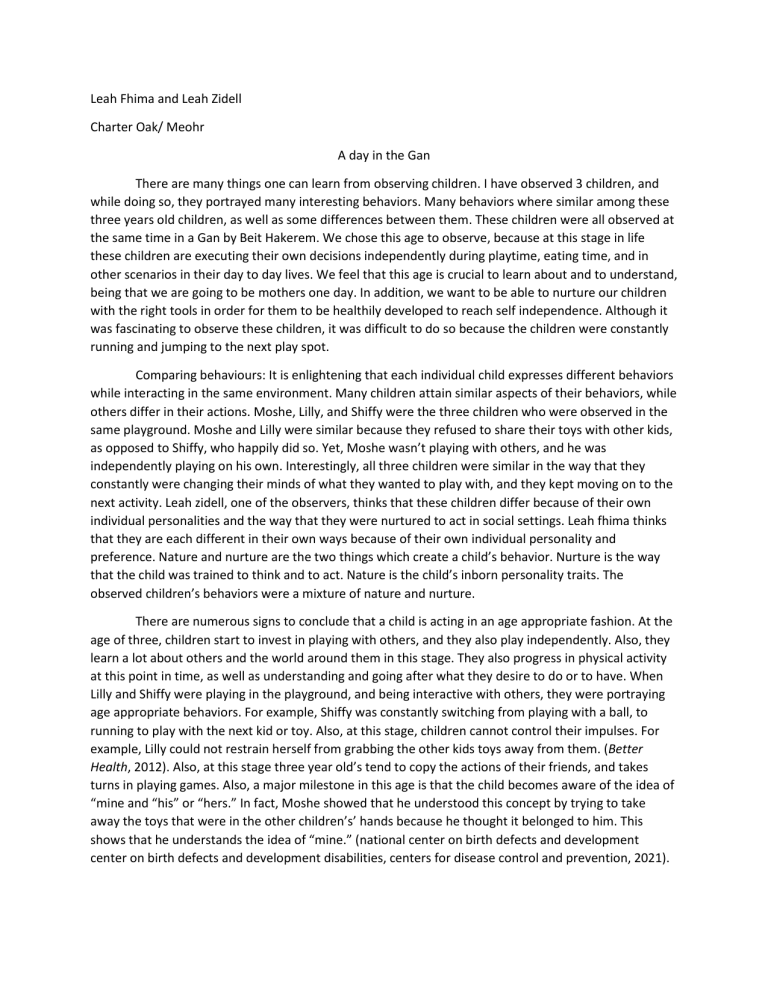
Leah Fhima and Leah Zidell Charter Oak/ Meohr A day in the Gan There are many things one can learn from observing children. I have observed 3 children, and while doing so, they portrayed many interesting behaviors. Many behaviors where similar among these three years old children, as well as some differences between them. These children were all observed at the same time in a Gan by Beit Hakerem. We chose this age to observe, because at this stage in life these children are executing their own decisions independently during playtime, eating time, and in other scenarios in their day to day lives. We feel that this age is crucial to learn about and to understand, being that we are going to be mothers one day. In addition, we want to be able to nurture our children with the right tools in order for them to be healthily developed to reach self independence. Although it was fascinating to observe these children, it was difficult to do so because the children were constantly running and jumping to the next play spot. Comparing behaviours: It is enlightening that each individual child expresses different behaviors while interacting in the same environment. Many children attain similar aspects of their behaviors, while others differ in their actions. Moshe, Lilly, and Shiffy were the three children who were observed in the same playground. Moshe and Lilly were similar because they refused to share their toys with other kids, as opposed to Shiffy, who happily did so. Yet, Moshe wasn’t playing with others, and he was independently playing on his own. Interestingly, all three children were similar in the way that they constantly were changing their minds of what they wanted to play with, and they kept moving on to the next activity. Leah zidell, one of the observers, thinks that these children differ because of their own individual personalities and the way that they were nurtured to act in social settings. Leah fhima thinks that they are each different in their own ways because of their own individual personality and preference. Nature and nurture are the two things which create a child’s behavior. Nurture is the way that the child was trained to think and to act. Nature is the child’s inborn personality traits. The observed children’s behaviors were a mixture of nature and nurture. There are numerous signs to conclude that a child is acting in an age appropriate fashion. At the age of three, children start to invest in playing with others, and they also play independently. Also, they learn a lot about others and the world around them in this stage. They also progress in physical activity at this point in time, as well as understanding and going after what they desire to do or to have. When Lilly and Shiffy were playing in the playground, and being interactive with others, they were portraying age appropriate behaviors. For example, Shiffy was constantly switching from playing with a ball, to running to play with the next kid or toy. Also, at this stage, children cannot control their impulses. For example, Lilly could not restrain herself from grabbing the other kids toys away from them. (Better Health, 2012). Also, at this stage three year old’s tend to copy the actions of their friends, and takes turns in playing games. Also, a major milestone in this age is that the child becomes aware of the idea of “mine and “his” or “hers.” In fact, Moshe showed that he understood this concept by trying to take away the toys that were in the other children’s’ hands because he thought it belonged to him. This shows that he understands the idea of “mine.” (national center on birth defects and development center on birth defects and development disabilities, centers for disease control and prevention, 2021). It is enlightening that each individual child expresses different behaviors while interacting in the same environment. Many children attain similar aspects of their behaviors, while others differ in their actions. Moshe, Lilly, and Shiffy were the three children who were observed in the same playground. Moshe and Lilly were similar because they refused to share their toys with other kids, as opposed to Shiffy, who happily did so. Yet, Moshe wasn’t playing with others, and he was independently playing on his own, while Lilly and shiffy were interacting with others. Interestingly, all three children were similar in the way that they constantly were changing their minds of what and who they wanted to play with, and they kept moving on to the next activity. Leah zidell, one of the observers, thinks that these children differ because of their own individual personalities and the way that they were nurtured to act in social settings. Leah Fhima believes that they are each different in their own ways because of their own individual personality and preference. Nature and nurture are the two things which create a child’s behavior. Nurture is the way that the child was trained to think and to act. Nature is the child’s inborn personality traits. The observed children’s behaviors were a mixture of nature and nurture. Moshe’s behavior surprised me because he refused to play with others. When other children would approach him, he would run away or say “go away”. The only time he initiated with others was because he wanted to steal their toy. The normal reaction of a three year old would be to interact with others and to enjoy the company of other kids. I expected Moshe to be similar to Lilly and Shiffy in the way that they were socially interactive with other children, and they were happy in doing so. Moshe rejected the initiation of others. From our observation we saw that Lilly possesses a bossy personality. She makes sure that she gets what ever she wants, when ever she wants. She has very good leading skills but uses them not in the nicest of way. Her confident leading behavior shows that she’s acquiring initiative over her ideas while interacting with her peers. According to Erikson psychosocial development, Lilly successfully grows through the stage of initiative vs. guilt. At this stage the primary feature involves the child regularly interacting with other children at school. Central to this stage is play, as it provides children with the opportunity to explore their interpersonal skills through initiating activities. When children are successful in this stage and in result, they develop a sense of initiative and feel secure in their ability to lead others and make decisions. In contrary, Moshe was playing alone and wasn’t interacting with others. In result, from my observation Moshe will have hard time having initiative over his ideas and executing his decisions because he isn’t gaining any support or validation in play. On the other hand, Shiffy likes interacting with others but a lot of the times she copies her friend’s actions. The bandura social learning theory explains a lot of Shiffy’s copycat behavior. The social learning theory is a process in which one leans behaviors from others and reproduces them. Child development theories help us understand children and what is the appropriate behavior for each stage of development. For example, Erikson’s initiative vs. guilt stage helped understand Lilly behavior when she was bossing around the kids. It told us that her interaction with others and her confidents in executing her ideas is healthy for a 3-year-old to successfully pass this stage. Yet, Child development theories also have their limitations, like the theory is generalized and can cause parents to think that there is something wrong with their child because they didn’t successfully pass a stage. For example, it might have seemed that since Moshe wasn’t playing with the other kids that he isn’t successful in Erikson’s initiative vs. guilt, but its only a theory and it can’t predict future behavior. Additionally, it could have been that for these 10 minutes of observing Moshe he was playing alone. I have learned that each child develops differently based off of their personality, and the way that they were raised. These observations can help me as a future parent because I will understand how I can benefit my child by nurturing him or her based off their personal needs, to help my child develop healthily. I will be able to teach my child the proper ways to interact with others, and to develop the confidence they will need when facing other children. I still need to learn what I can do to help my child through each individual stage of life in order that he or she will develop into an emotionally healthy child. Leah fhima has learned from these observations that every child is unique from one another and even if they act differently they still are developing according to the norm.as a future mother I want to keep this idea of that every child is unique and needs different things so they can successfully develop into their unique potential. I would love to learn more about the aspects of development that I should be looking out for as signs to seek help so that I don’t have to wait until its to late. Its when a child is young that he receives the most tools he needs to fully function in the world, when they get older its hard to introduce them new concepts.
